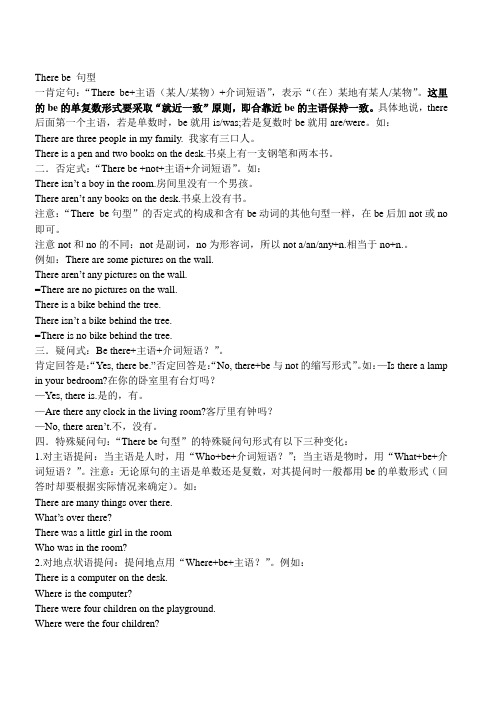There-be-句型详细讲解精品名师资料
- 格式:docx
- 大小:21.70 KB
- 文档页数:4

There be 句型一肯定句:“There be+主语(某人/某物)+介词短语”,表示“(在)某地有某人/某物”。
这里的be的单复数形式要采取“就近一致”原则,即合靠近be的主语保持一致。
具体地说,there 后面第一个主语,若是单数时,be就用is/was;若是复数时be就用are/were。
如:There are three people in my family. 我家有三口人。
There is a pen and two books on the desk.书桌上有一支钢笔和两本书。
二.否定式:“There be +not+主语+介词短语”。
如:There isn’t a boy in the room.房间里没有一个男孩。
There aren’t any books on the desk.书桌上没有书。
注意:“There be句型”的否定式的构成和含有be动词的其他句型一样,在be后加not或no 即可。
注意not和no的不同:not是副词,no为形容词,所以not a/an/any+n.相当于no+n.。
例如:There are some pictures on the wall.There aren’t any pictures on the wall.=There are no pictures on the wall.There is a bike behind the tree.There isn’t a bike behind the tree.=There is no bike behind the tree.三.疑问式:Be there+主语+介词短语?”。
“No, there+be与not的缩写形式”。
如:—Is there a lamp 肯定回答是:“Yes, there be.”否定回答是:in your bedroom?在你的卧室里有台灯吗?—Yes, there is.是的,有。





名师解读therebe句型therebe结构主要用以表达"某处某时有某人某物",其基本句型为"Therebe某物或某人某地或某时",其中there是引导词,没有词义,be是谓语动词;"某人或某物"是句子的主语,"某地或某时"作句子的状语,多是介词短语。
如:Thereisafootballunderthechair椅子下面有一个足球。
结构中的谓语动词be在人称和数上应与其后的主语保持一致。
主语是不可数名词或单数可数名词时用is,是复数时用are。
如:Thereisaflowerinthebottle瓶里有一朵花。
Thereissomemoneyintheeninthehouse房子里有一个男孩,一个女孩和两个妇女。
Therearetenstudentsandateacherintheoffice办公室里有十个学生和一个教师。
另外,在陈述句中为了强调地点,也可将介词短语提置句首。
如:Inthetreetherearefivebirds树上有五只鸟。
therebe结构的句型转换1否定句:therebe的否定式通常在be后加not构成在口语中be时常与not缩写在一起。
如果句中有some,一般要变成any。
如:Therearesomechildreninthepicture→Therearen't anychil dreninthepicture2一般疑问句及其答语:把be提到there前,首字母大写,句末用问号即可。
其肯定答语是Yes,thereis/are;否定答语为No,thereisn't/aren't。
如:-Aretheretwocatsinthetree?-Yes,thereareNo,therearen't3特殊疑问句及其回答:①提问句子的主语包括主语前的修饰语时,句型一律用"Whatis地点介词短语"无论主语是单数还是复数都用is。
A1. 定义:There be句型表示某处存在某物或某人。
A2. 结构: (1) There is + 单数可数名词/不可数名词 + 地点状语. (2) There are + 复数名词 + 地点状语. there是引导词,在句中不充当任何成分,翻译时也不必译出。
句子的主语是某人或某物,谓语动词be要与主语(某人或某物)的数保持一致。
当主语是两个或两个以上的名词时,谓语动词要与跟它最近的那个名词一致。
(就近原则)eg. ① There is a bird in the tree. 树上有一只鸟。
② There is a teacher and many students in our classroom. 我们教室里有一位老师和许多学生。
(就近原则)③ There are two boys and a girl under the tree. 树下有两个男孩,一个女孩。
(就近原则)A3. There be句型与have的区别:There be 句型和have都表示“有”的含义。
区别如下:There be表示“某处存在某物或某人”;have表示“某人拥有某物/某人”,它表示所有、拥有关系。
eg. ①He has two sons.他有两个儿子。
②There are two men in the office. 办公室里有两个男人。
A4. There +be+主语+修饰/说明成分(一) there be +主语+to do修饰语,用来修饰主语的不定式可以用被动形式,也可以用主动形式。
在口语中多用主动形式。
但是有时候两种形式可能表示不同的意思。
There is no time to lose /to be lost.试比较: There is nothing to see(nothing worth seeing).There is nothing to be seen(nothing there at all).(二) there be +主语+doing 修饰语There were 200children studying(=who were studying)music.Is there anything planned(=that has been planned)for tonight?(三) there be +主语+定语从句 (定语从句的关系代词做主语,也可以省略)There is something (that) puzzles me. There is a stranger (who) wants to see you.(四) there be +主语+同位语从句There came the news that the President had been murdered.A5. 句型转换一:否定句 There be句型的否定式的构成和含有be动词的其它句型一样,在be后加上not即可。
(完整版)therebe句型讲解与练习“There be句型”详解There be 句型1. 定义:There be句型表示某处存在某物或某人。
2. 结构:(1) There is +单数可数名词/不可数名词+ 地点状语.(2) There are +复数名词+地点状语.there是引导词,在句中不充当任何成分,翻译时也不必译出。
句子的主语是某人或某物,谓语动词be要与主语(某人或某物)的数保持一致。
当主语是两个或两个以上的名词时,谓语动词要与跟它最近的那个名词一致。
eg. ①There is a bird in the tree. 树上有一只鸟。
②There is a teacher and many students in our classroom. 我们教室里有一位老师和许多学生。
③There are two boys and a girl under the tree. 树下有两个男孩,一个女孩。
1).There be句型与have的区别首先,从含义上说,There be表达的是“某地有某物”。
如,There is a tree in front of the house。
房子前有一棵树。
而have讲的是“某人/某物拥有……”即指出的是宾语的所有者。
如:I have an interesting book。
我有一本有趣的书。
The chair has three legs。
这把椅子有三条腿。
其次,从直观上对比不难发现,一般There be句型直接置于句首,而have前面要有主语。
这是因为There be句型是一个倒装句型,主语在be动词后。
2.)There be句型的就近原则There be句型的就近原则也是主谓一致语法项目的重点考点。
There be句型中be动词的单复数形式由后面挨近的一项的单复数决定。
如:There is a pen, two books and many pencils on the desk。
There be句型
一肯定句:“There be+主语(某人/某物)+介词短语”,表示“(在)某地有某人/某物”。
这里的be的单复数形式要采取“就近一致”原则,即合靠近be的主语保持一致。
具体地说,there后面第一个主语,若是单数时,be就用is/was;若是复数时be就用are/were。
如:
There are three people in my family.我家有三口人。
There is a pen and two books on the desk.书桌上有一支钢笔和两本书。
二.否定式:“There be +not+主语+介词短语”。
如:
There isn’t a boy in the room.房间里没有一个男孩。
There aren’t any books on the desk.书桌上没有书。
注意:“There be句型”的否定式的构成和含有be动词的其他句型一样,在be后加not或no即可。
注意not和no的不同:not是副词,no为形容词,所以not a/an/any+n.相当于no+n.。
例如:There are some pictures on the wall.
There aren’t any pictures on the wall.
=There are no pictures on the wall.
There is a bike behind the tree.
There isn’t a bike behind the tree.
=There is no bike behind the tree.
三.疑问式:Be there+主语+介词短语?”。
肯定回答是:“Yes, there be.”否定回答是:“No, there+be与not的缩写形式”。
如:—Is there a lamp in your bedroom?在你的卧室里有台灯吗?—Yes, there is.是的,有。
—Are there any clock in the living room?客厅里有钟吗?
—No, there aren’t.不,没有。
四.特殊疑问句:“There be句型”的特殊疑问句形式有以下三种变化:
1.对主语提问:当主语是人时,用“Who+be+介词短语?”;当主语是物时,用“What+be+介词短语?”。
注意:无论原句的主语是单数还是复数,对其提问时一般都用be的单数形式(回答时却要根据实际情况来确定)。
如:
There are many things over there.
What’s over there?
There was a little girl in the room
Who was in the room?
2.对地点状语提问:提问地点用“Where+be+主语?”。
例如:
There is a computer on the desk.
Where is the computer?
There were four children on the playground.
Where were the four children?
3.对数量提问:一般有两种句型结构:
How many+复数名词+are/were (there)+介词短语?例如:
There’re many children in the park.
How many children are(there)in the park?
How much+不可数名词+is/was there+介词短语?例如:
There was little rain around the year.
How much rain was (there)around the year?
五.There be的其他用法
1.there be与have的替换。
there be表示所属关系时可与have替换。
There is nothing but a book in my bag.
=I have nothing but a book in my bag.我书包里只有一本书。
There are forty students in our class.
=Our class has forty students.我们班有四十名学生。
2.therebe后接表示物的主语时,后面常接不定式作定语,不定式常用主动形式表示被动意义。
There is a lot of work to do.有许多工作要做。
3.there be后接表示人或动物的主语时,后面长接V-ing形式作定语。
There are some children playing downstairs.几个孩子在楼下玩呢。
4.与其他词连用,构成复合谓语。
如:
There may be a heavy rain this afternoon.今天下午可能有一场大雨。
There used to be a cinema here before the war.战前这里有一个电影院。
5.there be结构中的be根据所表达的句意需要,可用live,stand,remain 等代替。
如:Once there lived a king who cared more about new clothesthan anything else.从前有一个国王,他喜欢衣物胜过一切。
There stands a high mountain in the middle of the woods.丛林中叠立着一座高山。
6.there be结构的反意疑问句应与there be对应,而不是依据主语。
如:There is a radio on the table, isn’t there?桌上有台收音机,是吗?
There aren’t any fish in the river, are there?河里没有鱼,是吧?
7.习惯用语there’snogood/use…(没有好处/没有用的)后常接V-ing形式。
如:。